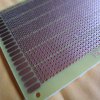The cheap no-name asian grow lights all have cases. It's only DIY builds that don't. A lot of the advantages you listed are not actually advantages.
NO ?
Almost none thermal derating of drivers and their caps ain't a great advantage ?
While "open frame drivers" is a cost/space advantage, "1 driver per cob" is not. I hang my 1 encased driver on the ceiling of my tent using straps. "1 driver per cob" is one of the major criticisms by LED critics, and I agree with that criticism. That's insane. In fact, the 1 driver also has high efficiency. (upto 94%), which was a major reason why I picked it. It even looks sleek! I love the way HLG-C looks.
Price/cost effectiveness was never mentioned by me ,neither as advantage ,neither as disadvantage .
Look, I think the quality of your work is amazing (way better than I could do with metal), but to suggest your lamp has better functionality because of it's sleek form is a bit of a stretch. Is the goal really to make the lamp more silent?
Yes,amongst others,yes.The fixture has to be silent.
Wouldn't removing the case make it even more silent? (less back pressure and turbulence)
.
Think it over for a minute or so ...
Back pressure ? Turbulence ? Why ?
I mean ,how those things will ever happen ,if the design won't allow ?
Also, without a case, there's extra money in the budget for a larger heat sink. You put 4 vero 29 at 2.1A right next to each other on a relatively small heat sink so it makes sense you'd complain about fan noise. You can not hear anything from my vero 18 based UFO killers at 700mA. (4 less powerful heat sources on a larger heat sink, farther away from each other) This might be moot point if a case is required for certification, but that's not your argument.
-Correction : 4 x 1,53 A
-Fan noise : Less than 19dB ( most dB meters won't even register the fan's noise even at 10 cm distance ... )
- Max
Tj of the four Veros is
Ta+25C at 1530 mA .... Beat that ,I challenge you ..
Just do not use a case ....
See if you can make it even close to Ta+25C and then ,we can continue , this discussion further on ..
As i've already mentioned ...
Diversity ..
Nothing and none is perfect ...
Some though ,are pretty much close ....
Trust me , to built the lights I built ,it takes lot more ,
than just placing a COB on heatsink and then connect a driver ....
There's plenty of calculations ,simulation ,real testing and more ,
that one can not see being connected or attached to the fixture ...
Trust me ,simplicity to be achieved ,needs a lot of complexity .
As for high efficiency to be achieved ,needs more than just high quality ,low driven COBs and/or drivers .
Another thing making a "efficient " device ,another thing the "efficient approach " of making a device .
Cheers.







